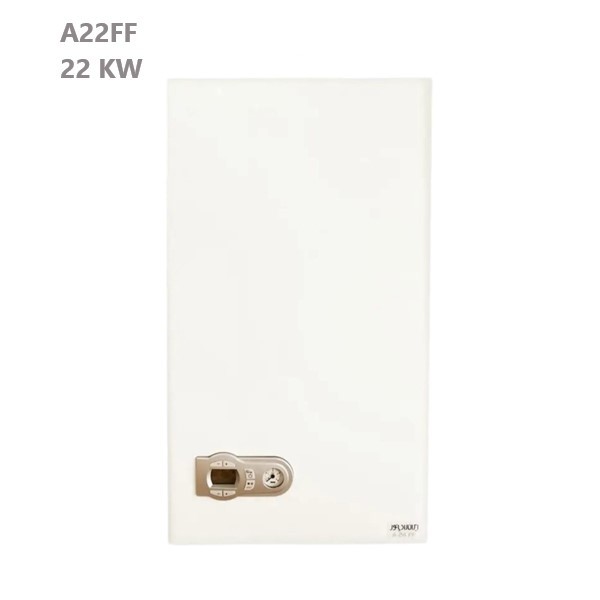Combi Boiler
A combi boiler (wall-mount and standing) is widely used to provide independent heating for residential and office units. The following provides the specifications, brands, models, analysis, capacity estimation tips, and the best purchase price of all combi boilers for wholesale purchase with warranty.
Combi Boiler Expert Buying Guide and Price List
The central combi boiler is the kind of device that can simultaneously supply hot water for consumption and heating water for each of the apartment units instead of the central engine room hot water boilers.
Wall-mounted or standing combi boilers can be easily installed in a cabinet place. In addition to higher efficiency, combi boilers have lower fuel consumption than those big boilers in the engine room.
In addition to eliminating extensive piping in the building, makes each unit independent in terms of providing heating and hot water consumption. In general, combi boilers are divided into two types: wall-mounted and standing in terms of placement and installation.
Review, Selection, and Pricing of HVAC Equipment
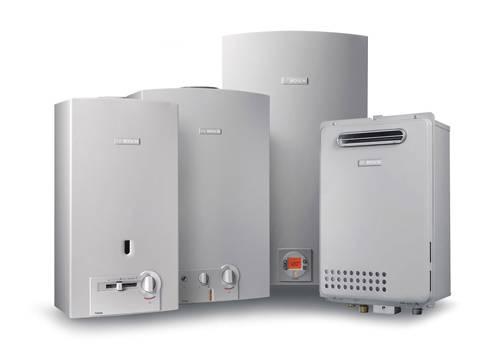
7 Factors to Consider When Selecting Combi Boilers
When buying a combi boiler, you should consider the 7 following parameters:
- Measure the area of the building or the area of your residential or office unit.
- Obtain the capacity of the desired combi boiler using the method of calculating the heating capacity mentioned below.
- Check the construction of the chimney (vertical to the roof or with a horizontal path) and if the chimney has a horizontal section, be sure to use a fan combi boiler.
- Select the type and model of your combi boiler according to the type of fuel available and the heating capacity obtained.
- Determine the wall or standing type of your combi boiler according to the installation space of the combi boiler in the building.
- Supply of fresh air or oxygen required for combustion of fuel consumed by the combi boiler (for units smaller than 65 square meters).
- According to Section 17 of the National Building Regulations (1390), the minimum area that can be approved for installing a combi boiler in an apartment unit (residential or office) is 64 square meters, otherwise, the use of a double-walled chimney or the installation of a fresh air supply vent to supply combustion air from the outside is mandatory at the installation location of the combi boiler.
Combi Boiler Capacity Determination
The capacity of the combi boiler means the effective heating power of the device, which is calculated in units of kilowatts (kW) or kilowatts per hour. This capacity indicates the heat a combi boiler can produce in one hour.
The capacity values of the combi boilers can be different and depend on the heating needs of the desired place.
The measurement of the capacity of the wall-mounted combi boiler in the form of kilowatts is usually done in ranges such as 24kW, 28kW, 30kW, and 35kW, and based on kilocalories, it is usually 28, 25, 20, 35 kilocalories per hour, and based on the heating requirement of the relevant unit, you can choose a wall mounted central heating or a suitable standing one.
There are two common methods to calculate the capacity of the combi boiler: the approximate method and the exact method.
Combi Boiler Approximate Capacity Calculation
To calculate the approximate capacity of the combi boiler (wall or standing) needed for apartment units, multiply the square footage of the unit by 150; for office units, multiply the square footage of the unit by 100; and for villas and buildings outside the city, multiply the square footage of the villa by 200 to get the capacity of the wall or standing combi boiler (gas or diesel) required for the relevant space.
DamaTajhiz: Thousands of products for thousands of projects (since 2004)
Combi Boiler Exact Capacity Calculation
In this method, various parameters are considered, such as:
- Weather conditions
- Geographic location
- Area dimensions
- Number of residents
- building materials
- Number and dimensions of windows and doors
- Heat transfer coefficients
- The amount of cold air entering the building and the air change rate
These are carefully calculated to determine the exact heating load of the particular unit. Facility engineers and professional consultants usually do the exact calculation of the capacity of the combi boiler.
Combi Boiler Capacity Calculation Formula
QT=[(U1*A1+U2*A2+U3*A3+…)∗ΔT+(V*0.0749*0.24* ΔT)]*4
• QT: Heating load of each unit in kilocalories per hour
• U1 to Un: Heat transfer coefficient of each surface between the inside and outside of the building in terms of BTU/ft2.hr. °F, which should be determined based on the material of each wall, using engineering reference tables.
• A: The area of each peripheral surface of the corresponding unit that transfers heat to the outside of the building. This area (in square feet) includes walls, windows, doors, and ceilings.
• ΔT: The temperature difference between the inside and outside of each unit under normal conditions, which is in °F.
• V: Total amount of air infiltrating through door or window seams (CFH) in ft3/hr
• Constant factor 0.0749: Air density in conventional conditions in the English system of units
• Constant coefficient of 0.24: Specific heat capacity of ambient air in conventional conditions in English units
You can get accurate results to determine the capacity of the combi boiler required for each building unit by calculating the values of all the parameters.
The exact values of U and area A for each surrounding surface must be considered based on specific details in each building and heat transfer coefficient tables.
Note: The heat required to provide hot water in standing and wall-mounted combi boilers is not calculated separately for heating systems and consuming water. When the hot water tap is opened, the combi boilers cut off the heating system of the unit and allocate their heating power to the hot water through the flow switch and the automatic brass tap using their second heat exchanger until the hot water tap remains open, and then again provide heating for the relevant unit heating system.
Different Types of Combi Boilers
The wall-mounted and standing combi boilers have different types that are designed based on the different sizes and capacities. To choose the right combi boiler, you must first determine the desired capacity and dimensions.
Here at the DamaTajhiz HVAC store, the technical information of dozens of models of wall-mounting and standing combi boilers from popular brands and with their main guarantee has been provided for you to enjoy the good feeling of optimal and smart shopping.
Types of Combi Boilers in Terms of Fuel Consumption
combi boilers are divided into four types according to the fuel type:
- Gas burner combi boiler (noiseless wall and standing)
- Diesel burner combi boiler (standing with the ability to be installed in the engine room or a warehouse outside the unit)
- Dual-burner combi boiler (standing with the ability to be installed in the engine room or a warehouse outside the unit)
- Electric combi boiler (noiseless wall and standing)
Note: Diesel and dual-burner combi boilers are mostly installed in the engine rooms of houses and private buildings that have front and/or backyards.
Types of Combi Boilers in Terms of Heat Exchanger Numbers
combi boilers, in terms of the number of heat exchangers, are divided into two categories:
Single heat exchanger combi boiler
The structure of the heat exchanger in these boilers is such that the heating system water pipe and the consumption water pipe are separated. Still, they are exposed to the flame of the burner at the same time, and the water inside them is heated simultaneously.
This results in quick hot water production and less depreciation of the combi boiler due to the inactivity of the pump in the summer season. It goes without saying that the amount of sedimentation in single-exchanger boilers is more than in double-exchanger ones, and the output water may have temperature fluctuations.
Double heat exchanger combi boiler
In double-exchanger combi boilers, one heat exchanger is installed to provide hot water for the heating system, and one heat exchanger (plate heat exchanger) is installed to provide healthy consumable hot water.
The water pipe of the heating system is directly exposed to the burner flame, but the plate heat exchanger provides the consumable hot water through heat exchange with the hot water of the heating system.
Due to the existence of a plate heat exchanger in the double exchanger combi boiler, hot water comes out with a uniform temperature, and the amount of sediment in these boilers is much less than in the single exchanger ones.
These categories are determined based on the number of heat exchangers in each central combi boiler, and each type of combi boiler may have differences based on other features and characteristics.
DamaTajhiz; Guide to Selection and Pricing of HVAC and Building Facilities Equipment (Since 2004)
The Right Place to Install a Combi Boiler
The installation location of the wall or standing combi boilers can have a great impact on their performance and efficiency. Each of these devices meets different needs according to the model and capacity. For the proper and optimal installation of the combi boiler, you must pay attention to the following:
The wall-mounted combi boiler is suitable for small houses and apartments of 60 to 180 square meters that have less space. Because this system takes up little space and in some cases gives a beautiful look to your environment. For example, residential units, office rooms, shops, or cafes with a maximum area of 180 square meters, which require proper and regular environmental heating, use this type of system.
Installing a wall combi boiler helps to beautify the environment, internal or external walls. These systems are usually installed secretly in the kitchen cabinets and are hidden from the normal view of people, which helps to beautify the space. Of course, it is necessary for the floor and ceiling of the wall cabinet where the combi boiler is installed to be completely open so that the proper airflow is available for complete combustion.
Standing combi boiler for large houses and villas of more than 200 square meters that need uniform heating in all their spaces, the standing combi boiler is a good option. Standing combi boilers, which are naturally installed on the ground, have more heating power, a hot water storage source, and a stronger circulator pump compared to their wall types, and based on the capacity and according to the information contained in the technical specification tables, even for substructures up to 400 square meters or More are also used!
Combi Boiler Performance in Different Seasons
As you know, in the cold seasons of the year, in addition to providing hot water, the combi boiler must also provide water for radiators and heating circuits. In the summer season, however, the only task of the combi boiler is to supply hot water for consumption.
In other words, whenever there is a need for hot water in summer, the combi boiler burner is turned on automatically when the faucet valve is triggered. As the water consumption is stopped and the device is turned off, the electronic board is all on that task.
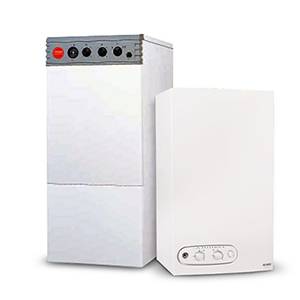
Technical Key Factors to Consider when Buying a Combi Boiler
Keep the following 7 technical key factors in mind when buying a combi boiler:
- Some models of combi boilers are equipped with a frost protection system, which must be turned on for the combi boiler to be active.
1.1. Connection to single-phase electricity
1.2. The minimum internal water pressure of the system and combi boiler according to the gauge or pressure gauge of the device must be 1 atmosphere or 1 bar.
1.3. Gas connection of the combi boiler (the advantage of these combi boilers is that they can be installed outdoors). - If your combi boiler is going to be placed in open areas such as a balcony, patio, or yard, you must use fan combi boilers that have an anti-freeze system. In addition, the frost protection system works if, firstly, the combi boiler is connected to electricity and, secondly, you have turned it on at least at a low temperature.
- A two-exchanger heating combi boiler is used in conditions where either the incoming water has hardness or the apartment's substructure is more than 120 meters.
- If the installation location of the device is outdoors, such as a balcony or patio, or where part of the chimney path is horizontal (more than 30 cm), a fan combi boiler is used.
The ventilation fan in the exhaust section of the combi boiler transfers combustion gases to the outside of the building. For this reason, the fan combi boiler is usually equipped with a special double-walled chimney the inner wall has a diameter of 6 cm. In this way, the combustion gases of the combi boiler are discharged to the outside environment through this chimney's outer diameter is 10 cm.
Double-exchanger combi boilers have a continuous flow of hot water due to having two heat exchangers (one for the radiator heating system and one for supplying hot water for consumption), which reduces sediment in the exchanger and also provides more hot water. - A single combi boiler can be used for two office units that do not consume much hot water. If the heating power of the combi boiler is proportional to the area of the aforementioned units and some technical measures are observed.
However, in the case of residential units, due to the limitation of hot water supply in the combi boilers and the possibility of simultaneous hot water consumption in two residential units, installing a combi boiler for two residential units (even if they have a small area) is not suitable. - Today, in many buildings, the heating supply system of the units consists of combi boilers with, radiator, ducted AC, and fan coil units in order to provide hot air in the cold season of the year, the hot water of the combi boilers must be able to reach and move in the fan coil unit or ducted AC.
In this case, due to the limited head or pressure of the circulator pump of wall-mounted combi boilers (6ft), it is necessary to calculate the diameter of the pipes and perform the piping of the heating system from the combi boiler location to the fan coil or split duct, exactly based on the closed system piping table and under the supervision of installation experts, so that the hot water of the combi boiler can reach the fan coil unit and ducted AC.

Combi Boiler Installation Location
These 7 tips will help you install your boiler in the most efficient way possible:
- The installation site of the combi boiler should not be above the gas stove and other heat-generating devices.
- The minimum distance from the floor to the bottom of the combi boiler is 120 cm.
- The distance between the device and the opposite wall should be at least 1 meter.
- The minimum distance from the adjacent wall or cabinet should be 15 cm on each side.
- The vertical distance from the adjustment cap of the combi boiler chimney to the chimney valve should be at least 50 cm.
- The chimney of the combi boiler should never be installed directly to the chimney vent inside the wall, but it should be placed at least 30 cm below the chimney vent. It is better to install the device as low as possible to the chimney valve. Increasing the distance between the combi boiler and the chimney valve increases the suction and improves the exit of combustion gases; however, if your device has a built-in fan, you can easily install it in a place where a part of the chimney runs horizontally.
- If you want to install the combi boiler inside the cabinet, note that the combi boiler device needs enough oxygen for combustion, so the bottom of the cabinet must be open. The cabinet door must be shuttered so that the device can receive the oxygen it needs from the environment.
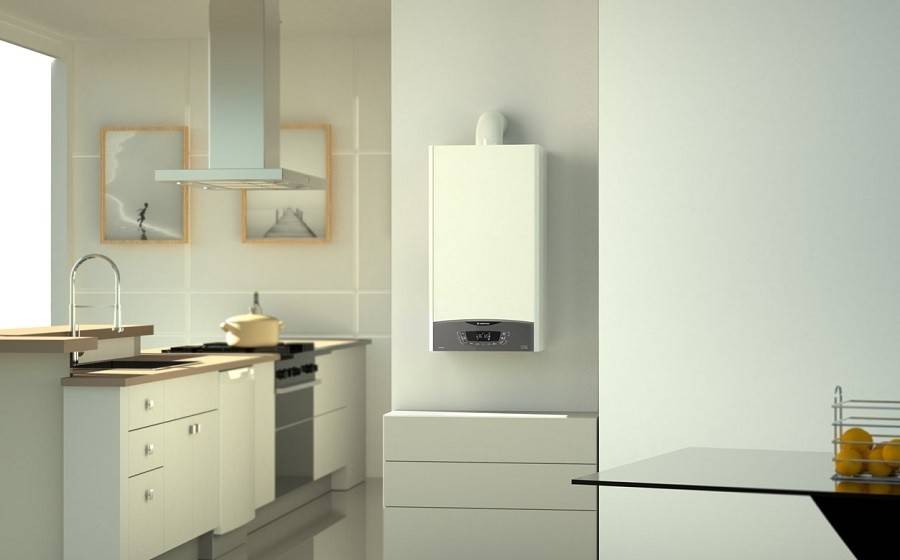
Differences Between Wall-Mounting and Standing Combi Boilers
These 3 differences are considered the most important ones and probably all that you need to know:
Location & Installation: The main differences between wall-mounted and standing combi boilers should be the different types of space and installation methods they require.
Heat Production: Standing ones are usually more powerful. Therefore, it is obvious that for places that require more heat production, a standing combi boiler is a far better option, especially for apartments and large houses.
Water Storage: Standing combi boilers have a coiled tank or water storage tank, and this difference is very important when there is a water cut or water pressure fluctuations.
DamaTajhiz; The Best Prices and Brands of Ventilation, Heating, and Building Facilities Equipment (Since 2004)
Buying Combi Boilers
Today, combi boilers are very popular among people from all around the world due to the independence of water consumption these devices offer.
To choose and buy the most suitable combi boiler from various models in bulk, you must first determine the capacity and type of the combi boiler. On the website of DamaTajhiz HVAC, technical information on dozens of combi boilers from reputed brands, along with the main guarantee, has been provided for you to enjoy the good feeling of optimal and smart shopping.
The Price of Combi Boilers
The prices of combi boilers vary based on the capacity, model, and brand available in the market; it should be noted that the prices presented on the DamaTajhiz HVAC website are all up-to-date, with a generous discount being applied to them. Therefore, the best price for all wall-mounted and standing combi boilers is guaranteed.
Also note that in the specialized HVAC group of Damatajhiz, all the combi boilers are only sold in bulk. Therefore, if you want to wholesale any of these products, contact us.
The price list of the best-selling wall-mounting and standing combi boilers
| Combi Boiler Brand | Heating Capacity | Position | Price (US$) |
| Butan | 22000 | Wall-mounted | from 367 to 566 |
| Butan | 24000 | Wall-mounted | from 377 to 567 |
| Iran radiator | 24000 | Wall-mounted | from 524 to 583 |
| Iran radiator | 28000 | Wall-mounted | from 600 to 617 |
| Chauffagekar | 24000 | Wall-mounted | from 733 to 759 |
| Chauffagekar | 28000 | Wall-mounted | from 813 to 839 |
| Chauffagekar | 36000 | Standing | from 1,180 to 1,389 |
| Chauffagekar | 65000 | Standing | from 1,723 to 1,887 |
| Lorch | 24000 | Wall-mounted | from 430 to 647 |
Please note that some models have asking prices, and prices may change. For more detailed information and more updated prices, you can contact the sales experts of Damatajhiz HVAC Group.
Dear Users
As you may be aware, throughout the colder months of the year, the combi boiler should also supply radiator water and heating circuits in addition to hot water.
The combi boiler should only supply hot water during the summer. In other words, whenever hot water is required, the combi boiler's burner is automatically activated by opening the hot water valve. When the water consumption is reduced, and the hot water tap is turned off, the burner is turned off, which is controlled by the Electronics board.
If you need more questions to decide on the purchase of wall-mounted and standing combi boilers after you read the above, you can contact the Sale of DamaTajhiz HVAC Group and ask your questions.
"Knowledge Fuels Better Choices"
Registered Trademark and Stewardship Business Licenses Issued by the Union of Virtual Business Association and the HVAC Equipment Industry.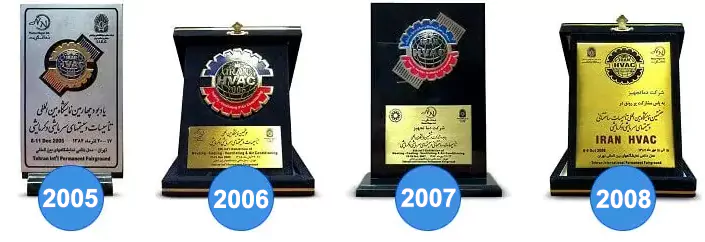
DamaTajhiz HVAC Participation at International HVAC and Construction Facilities Exhibitions Demonstrates its Global Reach and Commitment to the Industry.
We Look Forward to Your Call and the Opportunity to Meet With You
SHARE THIS CONTENT TO SPREAD THE KNOWLEDGE
| |
Head Office: No. 463,Talebian Alley,Taleghani St.Tehran,Iran


DamaTajhiz has provided the opportunity to sell and ship specialized HVAC equipment for applicants in the following countries as the first and the most popular online store for selling HVAC equipment (Heating , Ventilation , Cooling , Air conditioning) in the Middle East : Afghanistan – Tajikistan - Uzbekistan – Turkmenistan – Azerbaijan – Armenia – Georgia – Turkey – Iraq – Syria – Jordan – Kuwait – Emirates – Qatar – Oman.

